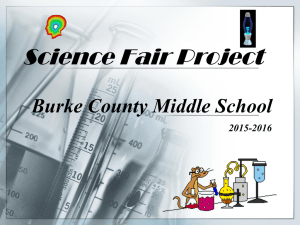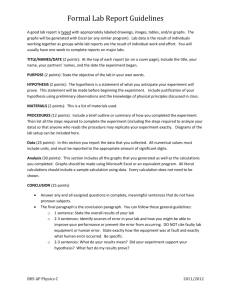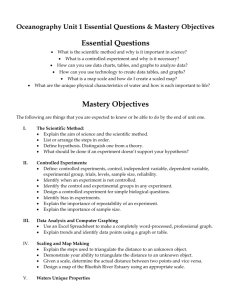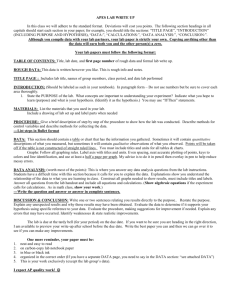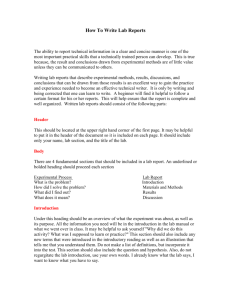Science FairPPT1 - Lincoln Prairie School
advertisement
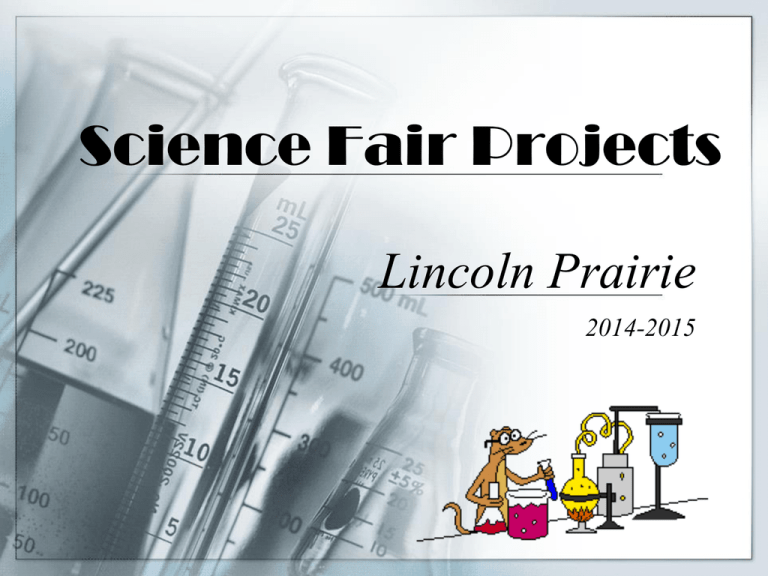
Science Fair Projects Lincoln Prairie 2014-2015 Concerns About Science Projects “So what kind of a project is required?” Allowable Projects: Experimental type projects that use the scientific method with a testable question. Ex. How Does aspirin affect the growth rate of roses? Projects Not Allowed: Research projects (What is a hurricane?) or models (a paper mache' volcano). These do not involve testing. Science Project Categories Physical: Projects related to the physical sciences such as physics, chemistry and astronomy that deal primarily with non-living materials. Science Project Categories Biological: Projects that deal with the vital processes of living organisms and how these processes are affected as a result of manipulating a variable. *No animals may be harmed*. Science Project Categories Environmental: Projects dealing with human’s relationship with the earth and human’s effect on the earth. The student should show clearly the connection between humans and their environment both in the written and oral presentation. Project Overview Variables Independent Variable The variable you are “messing with”. Dependent Variable The variable that you will measure and record. It’s changes “depend” on the independent variable. Control Variable All aspects of this variable must remain constant. “How Does Aspirin Affect the Growth Rate of Roses?” Ind. Dep. Cont. “What is the Effect of Coke on the Decay of Teeth?” Ind. Dep. Cont. Project Overview Hypothesis A hypothesis is a statement about what you think will happen in the experiment. It is stated in a positive manner. Avoid statements like “I think” and “I predict.” The hypothesis should be in the form of “If ___, then___.” Project Overview Hypothesis Examples: If I measure the bouncing height of a new basketball with three different pressures, then the ball with the highest pressure will bounce 10% higher. If I feed my dog four different dog foods, then he will like Alpo the best. If I survey all students in my kindergarten class about their favorite color gummy bear, then most students will choose green. Project Overview Materials The materials section is a detailed list of everything used in the experiment. Include what, how much, and what kind of things used. They are typically measured in metrics. Non-Example •Water •Flower pots •Seeds •Dirt Example •5 liters of rain water •Six 4 cm. clay pots •12 bush bean seeds •10 liters of potting soil Project Overview Procedure The procedure is a listing of steps used in the experiment. It is very detailed, like a recipe (cookbook format). It makes it easy for someone to duplicate the experiment. Project Overview Analyzing the Results Results include both data and observations. Look at measurements recorded in the Daily Log. Think about the data and observations and decide what those results mean. Try to use mathematical calculations such as mean, median, mode, and range (be sure your students know these words before using them). Construct graphs or tables that will show results clearly. Project Overview Writing the Conclusion Look at the data. The conclusion can be written in our conclusion format. Think about: Did the data support the hypothesis? If not, why do you think it did not? What would be done differently the next time? Do not worry about negative results, or results that come out differently than expected. Just explain why you think you got those results. If the results turned out as expected, explain why you think it turned out this way. Project Overview Bibliography This is an alphabetical listing of all books, articles, people, interviews, websites, etc. used as resources during the investigation. Examples of how to write bibliographies can be found at the following website: http://www.bialik.netaxis.qc.ca/homework/stylesheet2.htm http://www.noodletools.com Science Project Display Board Hypothesis Materials Problem (Title) Results The question that asks what you want to find out •_____ •_____ Research/Data •_____ pictures, charts, graphs or drawings Conclusion 1. _____ Variables I found out that ______ 2. _____ Control, dependent, and independent Procedure 3.______ References DiscoverySchool.com http://school.discovery.com/sciencefaircentral/ Discovery Channel’s guide to projects. Includes project ideas, questions & answers, tip sheets, and a “Parents-Get Involved” section. All Science Fair Projects http://www.all-science-fair-projects.com/ Browse ideas by topic or grade level. You can also search if you know your topic. Be sure to look at the grade level of the project. United States Department of Agriculture http://www.ars.usda.gov/is/kids/fair/ideasframe.htm Agricultural project ideas dealing with Chemistry, Botany, Environmental Science, Nutrition, Microbiology, and Zoology. References Bug Info http://www.si.edu/resource/faq/nmnh/buginfo/scifair.htm Projects related to insects. Charts and Graphs http://www.twingroves.district96.k12.il.us/ScienceInternet/ChartsGraphs.html Twin Groves Middle School in Buffalo Grove, Illinois has a great website that discusses different graphs that can be used to display data. http://nces.ed.gov/ncekids/graphing http://galenet.galegroup.com/servlet/SciRC?locID=fl_breva&bi=SU&bt=%2522Science+expe riments%2522&ste=10&st=b ►You can always use a search engine with the topic “science fair projects”. Be sure to find an appropriate project, not one that is just copied off of the internet.



